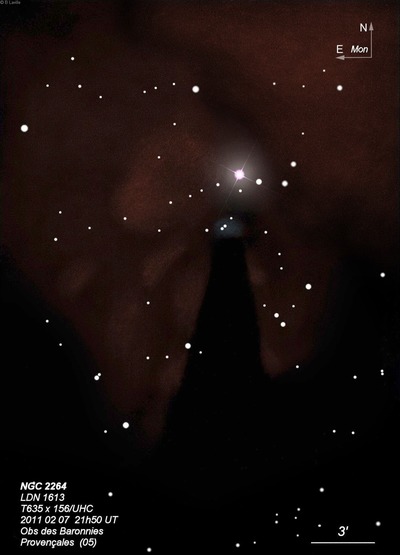Christmas Tree Cluster
Christmas Tree Cluster

William Herschel discovered NGC 2264 = H V-27 = H VIII-5 = h401 on 18 Jan 1784 (sweep 81) and recorded VIII-5 as "The 15th Mon is attended by above 30 considerable stars, and is itself a double star of the 3rd class. The star extremely unequal and probably not visible in smaller instruments. There is also another double star of the 3rd class not far from it consisting of equal stars." On 26 Dec 1785 (sweep 494) he logged V-27 as "I observed about 7' or 8' sp 15 Mon, some of the pB stars to be contained within vF milky nebulosity which loses itself imperceptibly; but there remains a doubt of the reality." On the 28 Dec 1785 (sweep 496) he mentioned "I examined the stars south preceding 15 Mon and believe they contain Milky nebulosity. It is very difficult to ascertain it on account of the glare of the 15th, but I have hardly any doubt. Again on 11 Jan 1787 (sweep 682) he noted "I suspect the sp 2 stars (of which one is Double [15 Mon] to be affected with vF milky nebulosity but may be a deception." WH's descriptions and position apply to the cluster and to the brightest part of the nebulosity southwest of mag 4.7 S Monocerotis. John Herschel also reported on 18 Jan 1828 (sweep 120), "a *5.6 enveloped in a nebulous haze.", although he may have just seen scattered light around the bright star.
The region around 15 Mon was examined a number of times at Birr Castle, searching for nebulosity. There were 9 negative results before 1861 and Lord Rosse wrote "No neby. Found, and only a few stars arranged in pairs; no cl. Has there been a change here? Heinrich d'Arrest also missed seeing nebulosity in 1862 at Copenhagen with the 9" refractor. But successful observations were made at Birr Castle in 1863 and 1878 (the later by Dreyer). E.E. Barnard and Roberts reported extensive nebulosity in the region based on photographs.
On 10 May 1895 Isaac Roberts showed a three-hour exposure of the NGC 2264 complex taken with his 20-inch reflector on 13 Feb to a meeting of the Royal Astronomical Society. It clearly showed the nebulosity southwest of S Mon (first photographed by Barnard in 1894) but also revealed a “conical dark space bounded by a rim of nebulosity” — this is the famous ‘Cone Nebula’.
200/250mm - 8" (11/5/83): bright, very large, scattered, Christmas tree outline, fairly rich, includes multiple star south Mon.
300/350mm - 13" (11/5/83): very bright, very large scattered group, elongated N-S, striking Christmas tree shape. A bright multiple star 15 Monocerotis = south Mon (4.7-7.5 at 2.8" and companions) is at the base of the tree at the north end of the cluster and is surrounded by several stars. Easy nebulosity is visible which extends 10' SW of south Mon and includes a group of three brighter stars. At the south end of the cluster is the double star ∑954 = 7.1/9.6 at 13". The Cone nebula (not seen) extends south of ∑954 and "points" towards ∑954.
400/500mm - 17.5" (12/28/00): besides the bright nebulosity extending southwest of mag 4.7 S Monocerotis (15), most of the central region of the cluster was set against a weakly glowing background (part of Sh 2-273). At the southern end of the cluster (tip of the "Christmas Tree"), this low surface brightness glow was more evident and clearly extended beyond the 7th magnitude star at the tip towards the SE. The west edge of this weakly glowing extension forms the eastern border of the dark Cone Nebula (LDN 1613). There is a lack of faint stars within the region of the Cone Nebula but the inclusion itself was not darker than the general background.
17.5" (12/30/99): nebulosity was quite prominent to the SW of south Mon as well as a weaker glow in the vicinity around ∑954 at the south end of the cluster. At 100x (unfiltered) there appeared to be a slightly darker vacuity to the south of this star in the position of the Cone nebula but there is no sharp "edge" with the nearby nebulosity.
Naked-eye - (1/8/00): vislble as a 4th magnitude nebulous glow including the mag 5 star (S Mon), but appears much smaller naked-eye than the listed dimensions.
Notes by Steve Gottlieb